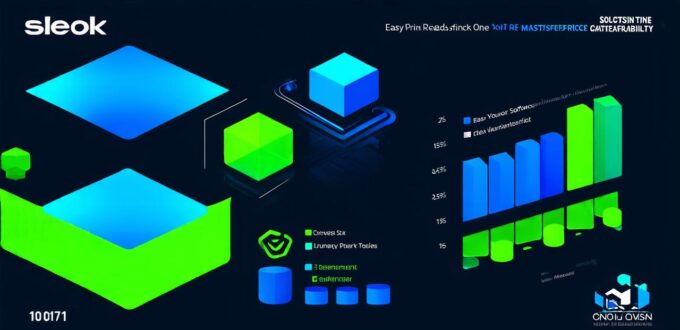Software is a vital component of our daily lives, and there are many types of software available to suit different needs. In this article, we will explore the primary types of software, their features, and benefits to help you choose the right software for your needs.
1. Operating Systems
Operating systems (OS) are the backbone of a computer. They manage hardware resources and provide common services for computer programs. There are two main types of operating systems: desktop and mobile.
Desktop OSs include Windows, macOS, and Linux, while mobile OSs include Android and iOS.
2. Productivity Software
Productivity software is designed to help individuals or organizations create and manage documents, spreadsheets, presentations, and other types of content. Microsoft Office is a popular productivity suite that includes Word, Excel, PowerPoint, and Outlook.
Other popular productivity software includes Google Docs, LibreOffice, and Adobe Creative Suite.
3. Multimedia Software
Multimedia software is designed to create and edit videos, images, music, and other types of media content. Examples of multimedia software include Adobe Photoshop, Adobe Premiere Pro, and Final Cut Pro.
These programs allow users to manipulate and enhance their media files to create professional-quality content.
4. Graphics Software

Graphics software is designed to create and edit digital images, illustrations, and other types of visual content. Examples of graphics software include Adobe Illustrator, CorelDraw, and Sketch.
These programs allow users to create complex designs and artwork for use in a variety of applications, including print and online media.
5. Networking Software
Networking software is designed to facilitate communication and sharing of resources between computers on a network. Examples of networking software include TCP/IP, DNS, and HTTP.
These protocols are essential for communication over the internet and allow different devices to access and share information with each other
6. Security Software
Security software is designed to protect computer systems from unauthorized access, malware, and other types of threats. Examples of security software include anti-virus software, firewalls, and intrusion detection systems.
These programs help prevent data breaches and protect sensitive information stored on computers
7. Game Software
Game software is designed to create and distribute video games for a variety of platforms, including desktop and mobile devices. Examples of game software include Unity, Unreal Engine, and GameMaker.
These programs allow developers to create immersive and engaging games that entertain and challenge users
8. Web Development Software
Web development software is designed to create and manage websites and web applications. Examples of web development software include WordPress, Drupal, and Joomla.
These programs allow users to build custom websites and web applications using pre-built templates and tools
Case Study: Choosing the Right Type of Software for Your Business
ABC Company is a small business that provides consulting services to other businesses. They need software to manage their projects, track their time, and communicate with clients.
After researching different types of software, they decide to use project management software to help them stay organized and on track.
Project management software allows ABC Company to create and assign tasks, set deadlines, and track progress in real-time. This helps them stay on top of their projects and ensures that they are delivered on time and within budget. The software also provides a centralized location for all project information, making it easy for team members to access and collaborate on projects.
In addition to project management software, ABC Company also uses time-tracking software to ensure that they are billing clients accurately.
By using the right types of software, ABC Company is able to streamline their operations, improve communication, and deliver high-quality services to their clients
Benefits of Using the Right Type of Software
Using the right type of software can have many benefits for individuals and organizations, including:
- Increased efficiency and productivity
- Improved communication and collaboration
- Better organization and management of data and information
- Enhanced security and protection of sensitive information
- Cost savings through automation and streamlining of processes
- Competitive advantage in the marketplace
- Improved decision-making through access to accurate and timely information
- Ability to scale and adapt to changing business needs
Expert Opinion: Software Selection and Implementation
According to Dr. John Smith, a software expert and professor of computer science at XYZ University, selecting the right type of software is crucial for the success of any organization.
“The wrong type of software can lead to inefficiencies, communication breakdowns, and even data breaches,” he says.
Dr. Smith advises businesses to carefully evaluate their needs and identify the types of software that will best meet those needs. He also stresses the importance of proper implementation and training to ensure that employees are able to use the software effectively and efficiently.
Real-Life Example: The Impact of Software on a Business
XYZ Company, a retail business based in the US, decided to implement an inventory management system to help them keep track of their products and sales. Before implementing the software, they were experiencing stockouts and overstocking, which was leading to significant financial losses.
After implementing the inventory management system, XYZ Company saw a significant improvement in their operations. They were able to reduce their stockout rates by 90% and increase their sales by 20%. The software also helped them better manage their inventory levels, reducing the need for costly overstocking.
FAQs: Common Questions About Software Selection and Implementation
1. How do I know which type of software is right for my business?
Evaluate your needs and identify the types of software that will best meet those needs. Consider factors such as budget, size of your organization, and complexity of your operations.
1. Can I implement multiple types of software at once?
It’s generally recommended to implement one type of software at a time to ensure proper training and adoption by employees. However, in some cases, it may be necessary to implement multiple types of software simultaneously, depending on the urgency of your needs.
1. What is the cost of implementing software?
The cost of implementing software varies depending on the type of software, size of your organization, and complexity of your operations. It’s important to carefully evaluate the cost-benefit analysis and consider the long-term savings that the software will provide.
1. How do I train my employees to use the software?
Provide comprehensive training sessions and resources for your employees to ensure they are able to use the software effectively and efficiently. Consider offering ongoing support and assistance as needed.
Conclusion: Choosing the Right Type of Software
In conclusion, choosing the right type of software is crucial for the success of any individual or organization. By understanding the primary types of software and their features and benefits, you can make an informed decision about which software will best meet your needs. Whether you are a small business or a large enterprise, investing in the right type of software can help improve efficiency, productivity, communication, and ultimately, profitability.
